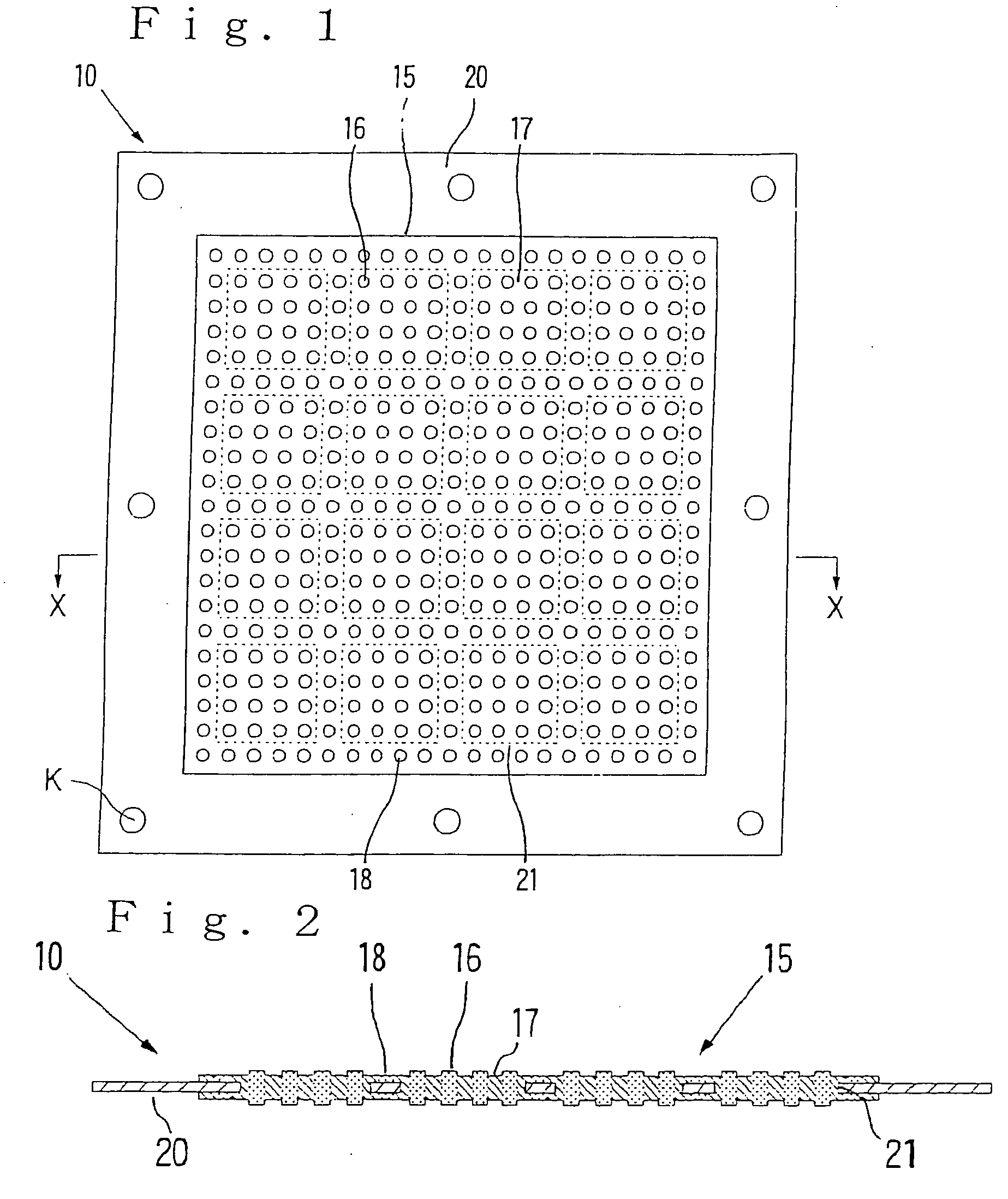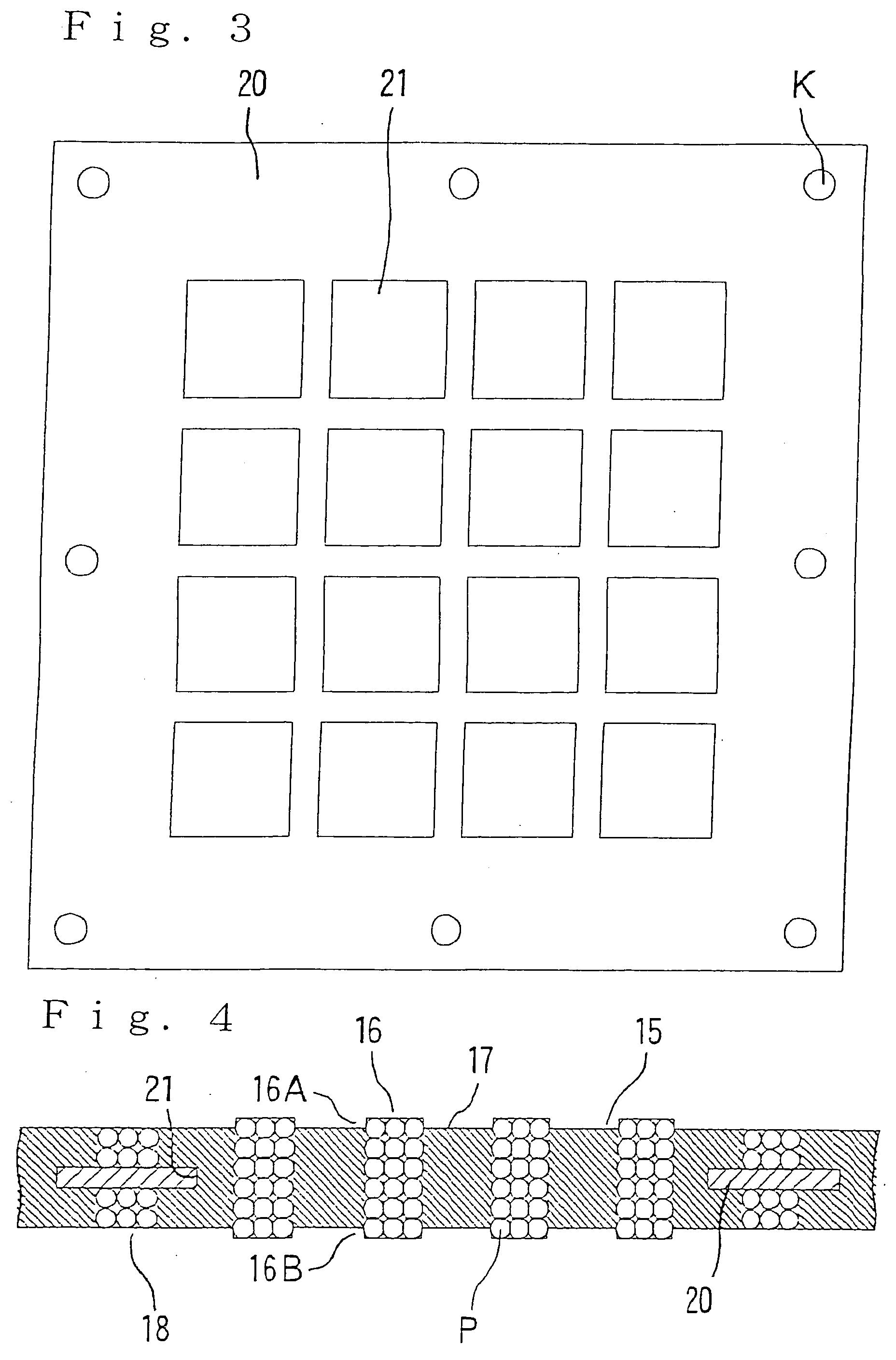Anisotropic conductive connector and wafer inspection device
- Summary
- Abstract
- Description
- Claims
- Application Information
AI Technical Summary
Benefits of technology
Problems solved by technology
Method used
Image
Examples
production example 1
of Mold
[0263] A brass plate having a thickness of 3.0 mm was provided, a plurality of magnetic member-receiving recesses, which each had a circular section whose diameter was 0.3 mm and whose depth was 2.7 mm, were formed in one surface of such a non-magnetic base plate by a drilling machine at a pitch of 0.8 mm in an X-X direction (the direction means a direction corresponding to the X-X direction in FIG. 1; the same shall apply hereinafter) and a pitch of 0.8 mm in a Y-Y direction (the direction means a direction perpendicular to the X-X direction; the same shall apply hereinafter) and a plurality of projected portion-forming recesses, which each had a circular section whose diameter was 0.3 mm and whose depth was 0.05 mm, were formed in the other surface of the non-magnetic base plate at a pitch of 0.8 mm in the X-X direction and a pitch of 0.8 mm in the Y-Y direction, thereby producing a non-magnetic base plate. A spherical magnetic member made of iron and having a diameter of 0...
production example 2
of Mold
[0265] An iron plate having a thickness of 6 mm was provided, and one surface of this iron plate was subjected to a photo-etching treatment using a dry film resist and ferric chloride, thereby producing an intermediate in which a plurality of disk-like ferromagnetic substance layers each having a thickness of 0.1 mm and a diameter of 0.25 mm had been integrally formed at a pitch of 0.65 mm in the X-X direction and a pitch of 0.65 mm in the Y-Y direction on a ferromagnetic base plate made of iron and having a thickness of 5.9 mm.
[0266] Non-magnetic substance layers each having a thickness of 0.15 mm were formed at other areas than the ferromagnetic substance layers on said one surface of the intermediate by using a resist, thereby making a top force. A bottom force was made in the same manner as in the production of the top force to produce a mold of the construction shown in FIG. 7. This mold is referred to as “Mold b”.
production example 3
of Mold
[0267] An iron plate having a thickness of 6 mm was provided, and one surface of this iron plate was subjected to a photo-etching treatment using a dry film resist and ferric chloride, thereby producing an intermediate in which a plurality of disk-like ferromagnetic substance layers each having a thickness of 0.1 mm and a diameter of 0.40 mm had been integrally formed at a pitch of 1.00 mm in the X-X direction and a pitch of 1.00 mm in the Y-Y direction on a ferromagnetic base plate made of iron and having a thickness of 5.9 mm.
[0268] Non-magnetic substance layers each having a thickness of 0.2 mm were formed at other areas than the ferromagnetic substance layers on said one surface of the intermediate by using a resist, thereby making a top force. A bottom force was made in the same manner as in the production of the top force to produce a mold of the construction shown in FIG. 7. This mold is referred to as “Mold c”.
PUM
 Login to View More
Login to View More Abstract
Description
Claims
Application Information
 Login to View More
Login to View More - R&D
- Intellectual Property
- Life Sciences
- Materials
- Tech Scout
- Unparalleled Data Quality
- Higher Quality Content
- 60% Fewer Hallucinations
Browse by: Latest US Patents, China's latest patents, Technical Efficacy Thesaurus, Application Domain, Technology Topic, Popular Technical Reports.
© 2025 PatSnap. All rights reserved.Legal|Privacy policy|Modern Slavery Act Transparency Statement|Sitemap|About US| Contact US: help@patsnap.com



